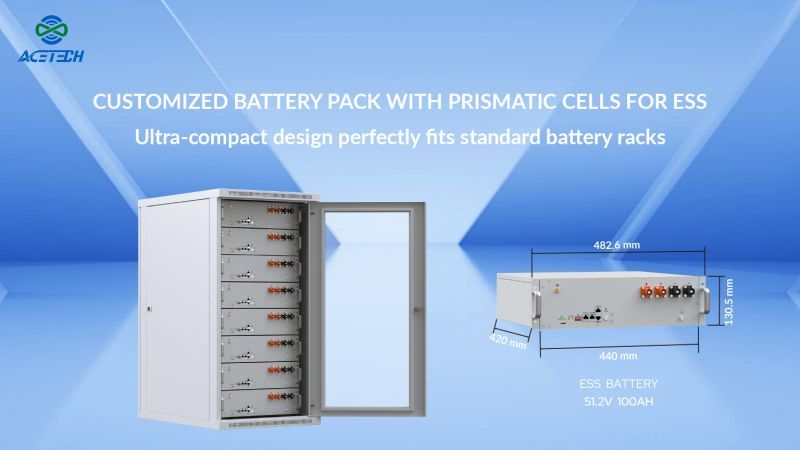
Inquiry
Rack Mount LiFePO₄ Batteries for Energy Storage Projects
When designing modern energy storage systems, one recurring question engineers face is, How can we deliver high energy density without sacrificing rack space, thermal control, or integration efficiency?
Rack-mounted LiFePO₄ batteries offer a compact, scalable solution engineered specifically for these demands. Their compatibility with standard 19-inch enclosures, extended cycle life, and robust safety profile make them a preferred choice in projects where space, reliability, and adaptability matter.
Whether you're equipping a new telecom site, upgrading an edge computing rack, or integrating backup storage for distributed solar, understanding how to select and deploy the right rack mount lithium battery can significantly impact long-term performance and maintenance overhead.
What Is a Rack Mount LiFePO₄ Battery?
A rack mount LiFePO₄ battery is a lithium iron phosphate (LiFePO₄) energy storage module designed specifically for installation in standard 19-inch equipment racks. Typically built in 3U to 5U height formats with front-facing terminals and mounting rails, these batteries allow for modular stacking, streamlined cable management, and direct compatibility with IT, telecom, and industrial power infrastructure.
Unlike wall-mounted or floor-standing systems, a rack-mounted lithium battery integrates directly into cabinet environments—making it ideal for applications where space optimization, clean layout, and fast maintenance access are essential. Each module typically includes a built-in Battery Management System (BMS), supporting communication protocols such as CAN or RS485 for seamless system integration.
The use of LiFePO₄ chemistry brings further benefits: longer cycle life (often exceeding 6,000 cycles), improved thermal stability, and enhanced safety performance—key factors in applications requiring long service life and low maintenance.
By combining mechanical standardization with robust lithium iron phosphate performance, rack-mounted battery systems have become a foundational component in today’s scalable energy storage projects.
Why Choose Rack-Mounted LiFePO₄ Batteries for Modern Energy Systems?
When deploying an energy storage solution—whether for telecom, solar backup, or edge infrastructure—the mechanical design of the battery plays a critical role in installation speed, space utilisation, and long-term serviceability. A rack-mounted LiFePO₄ battery is purpose-built to solve these challenges.
1. Optimised for Standard Rack Enclosures
Rack-mount batteries are designed around the 19-inch industry standard, with 3U or 5U heights and 400–600 mm depths. This allows for direct installation into existing IT racks, telecom cabinets, or modular ESS enclosures—without the need for custom mounting brackets or external battery cabinets.
For system integrators, this translates into faster deployment and greater compatibility across sites and use cases.
2. Space-Efficient Energy Storage
With footprints as low as 3U × 420 mm, a single rack mount lifepo₄ battery can deliver over 5 kWh of usable energy while occupying minimal rack space. Modules can be stacked vertically or deployed in parallel across adjacent racks, helping projects scale from 5 kWh to over 200 kWh without redesigning infrastructure.
This makes rack-mounted solutions ideal for locations where real estate is limited—such as indoor telecom shelters, microgrid containers, or compact server rooms.
3. Plug-and-Play Integration with Front Access Design
Most rack-mounted batteries offer front-access terminals, front-facing breakers, and quick-connect communication ports. This design simplifies cable routing, enables faster maintenance, and supports safe, modular expansion. In many cases, installation does not require special tools or electrical enclosures.
Advanced units may also include hot-swappable modules, LED indicators, or remote diagnostics—all accessible from the front panel.
4. Stable, Long-Lasting LiFePO₄ Chemistry
Using LiFePO₄ cells brings well-known benefits:
- Cycle life exceeding 6,000 cycles at 80% depth of discharge
- Excellent thermal performance (safe operation up to ~55 °C)
- Low risk of thermal runaway compared to NMC or LCO chemistries
This durability is especially important for systems in continuous operation—where battery replacement costs and system downtime must be minimised.
In summary, a well-designed rack mount lithium battery not only saves space and simplifies system architecture, but also reduces operational costs over the full lifecycle of your energy storage project.
What Technical Specifications Can Be Customised?
No two energy storage projects are identical. Depending on your system layout, inverter compatibility, cabinet depth, or communication protocol, standard battery modules may require adjustment. That’s why many rack mount LiFePO₄ batteries offer flexible specification options that can be tailored to fit your exact setup.
Here’s a breakdown of the key parameters that can typically be customised:
| Parameter | Typical Range | Customisation Options |
|---|---|---|
| Nominal Voltage | 48V / 51.2V | Configurable between 40V–60V to match DC bus of inverter |
| Capacity | 50Ah–200Ah | Adjusted via cell selection (e.g., 280Ah, 310Ah) and parallel stringing |
| Rack Height (U) | 3U / 4U / 5U | Slimline 2U or compact 3U designs for space-constrained enclosures |
| Depth | 400–600mm | Short-depth (~420mm) for shallow telecom cabinets or edge sites |
| Communication | CAN, RS485 | Add support for Modbus TCP, SNMP, Ethernet/IP, Wi-Fi as needed |
| BMS Features | Basic cell protection | Advanced options: data logging, fault alarms, remote diagnostics, black-box recorder |
| Mechanical Details | Standard black faceplate | Custom branding, panel color, connector layout, front handle style |
| Certifications | UN 38.3, CE | Optional: UL 1973, IEC 62619, UKCA, marine DNV, CB |
These custom rack battery options ensure that energy storage systems can be optimised—without compromise. Whether you're integrating into a telecom enclosure, a modular microgrid cabinet, or a multi-rack solar system, the ability to adjust form factor and electrical performance allows for a seamless fit.
Looking for short-depth modules with front I/O and CAN-to-Modbus bridge support? Or planning to match a high-voltage ESS string with multi-parallel 48V units? These parameters are fully configurable within ACE Battery’s rack-mounted lithium battery platform.
Where Are Rack Mount Batteries Most Effectively Used?
The strength of a rack mount LiFePO₄ battery lies not only in its format, but in its ability to adapt to a wide range of energy storage applications. Whether the goal is backup power, load balancing, or renewable integration, rack-mounted batteries are particularly effective in the following use cases:
Telecom and Edge Infrastructure
In remote shelters or base stations, space is at a premium—and reliability is non-negotiable. A 3U or 5U rack-mounted lithium battery fits directly into ETSI racks, enabling clean installation alongside network hardware.
Benefits:
- Short-depth modules (e.g., 420mm) fit shallow cabinets
- Remote SOC monitoring reduces the need for on-site visits
- Operates safely across wide temperature ranges (–20 °C to 55 °C)
Data Centers and Server Rooms
Uninterruptible Power Supply (UPS) systems depend on battery banks that can be hot-swapped, monitored, and maintained without downtime. Rack-mounted LiFePO₄ batteries deliver consistent performance with minimal footprint.
Benefits:
- High cycle life = low replacement frequency
- 19" rack compatibility streamlines cable management
- Smart BMS supports remote diagnostics and alarms
Solar + Storage Systems
For distributed PV systems—especially in residential or small commercial applications—a rack battery setup allows you to build scalable capacity in 5–100 kWh increments.
Benefits:
- Easily paired with 48V hybrid inverters
- Modular stacking = flexible energy blocks
- Eliminates the need for floor-mounted battery cabinets
Microgrid and Emergency Power Systems
In industrial sites, healthcare facilities, or rural grids, reliable energy buffering is critical. A rack-mounted solution enables compact deployment in control rooms or inside prefabricated ESS containers.
Benefits:
- Easy expansion by adding parallel rack modules
- Compatible with centralized EMS platforms
- Enhanced system reliability with distributed architecture
How to Integrate Rack Batteries into Existing Systems?
To ensure smooth deployment, a rack-mounted LiFePO₄ battery must be correctly matched to its mechanical, electrical, and software environment. Here are five key integration areas to consider:
Mechanical Fit
Confirm rack dimensions—height (U), depth, and front clearance. Allow ≥75 mm rear ventilation space if natural cooling is used.
Electrical Interface
Ensure DC bus voltage matches battery output (typically 48–51.2 V). Size cables to maintain <1% voltage drop.
Thermal Management
Design cabinet airflow accordingly. For high ambient or continuous high-load use, consider forced ventilation or optional liquid cooling.
Communication Setup
Select compatible BMS interface: CAN, RS485, or Modbus. ACE batteries support multiple protocol profiles for inverter or EMS connection.
Regulatory Compliance
Follow UL, IEC, or local standards. Ensure clear labeling, spacing, and overcurrent protection per region.
ACE Battery provides rack modules with front-access terminals, unified mounting rails, and flexible communication settings—making integration into existing ESS racks simpler and faster.
How to Select the Right Rack-Mounted LiFePO₄ Battery for Your Project?
Choosing a rack-mounted LiFePO₄ battery goes beyond just voltage and capacity. The right selection balances mechanical compatibility, electrical performance, communication requirements, and future scalability. Here’s a practical guide to help ensure your system is optimally matched from the start:
1. Define Your Voltage and Capacity Requirements
- Nominal voltage: Most rack batteries operate at 48 V or 51.2 V.
- Capacity per module: Common options range from 50 Ah to 200 Ah, depending on your runtime, peak load, and charge/discharge cycles.
- Tip: Start with your inverter’s voltage window and total energy needs, then divide by rack unit capacity to estimate module count.
2. Check Rack Dimensions and Installation Space
- Match U-height to available vertical space (e.g., 3U = ~133mm).
- Confirm cabinet depth—ACE’s 3U 100Ah module fits in 420mm, ideal for shallow telecom or wall-mounted racks.
- Allow space for cable clearance, airflow, and door clearance if applicable.
3. Evaluate Communication & Monitoring Needs
- Will your inverter or EMS require CAN or RS485?
- Do you need remote monitoring, fault alarms, or data logging?
- Is protocol conversion (e.g., CAN to Modbus TCP) needed?
ACE’s rack batteries come with selectable BMS protocols and can support firmware customization to match third-party systems.
4. Consider Scalability and Parallel Design
- For systems >10 kWh, ensure the battery supports parallel connection (up to 64 units on ACE’s BMS).
- Confirm balancing logic and communication sync between modules.
5. Identify Any Certification or Compliance Requirements
- For export, grid-tie, or sensitive projects, verify if UL 1973, IEC 62619, or CE/UKCA markings are needed.
- Check if fire spacing or cabinet grounding is required under NFPA 855 or local codes.
Selection Checklist
- Voltage and total capacity required
- U-height and cabinet depth
- Output current vs inverter draw
- Communication protocol compatibility
- Operating temperature range
- Compliance or regional certification needs
With a wide range of rack-mount lithium battery options available, selecting the right module isn’t just about size or chemistry—it’s about ensuring long-term integration success and upgrade flexibility.
How Does ACE Battery Deliver Reliable, Custom Rack Solutions?
Choosing a battery is only half the solution—making it work seamlessly in your system requires thoughtful engineering, tight mechanical design, and robust quality control. That’s where ACE Battery stands apart.
Here’s how we support your energy storage projects with precision-fit rack-mounted LiFePO₄ solutions:
Ultra-Compact Design, Standards-Ready
Our core rack module—51.2V 100Ah in 3U height and 420mm depth—is engineered to fit directly into standard 19-inch racks. Whether you're deploying in shallow telecom cabinets or dense IT enclosures, ACE ensures mechanical fit with no redesign needed.
True Plug-and-Play Installation
No special battery cabinet? No problem. ACE modules feature front-facing terminals, standard rails, and universal communication ports (CAN, RS485, optional Modbus TCP)—enabling fast, low-cost deployment in both new and retrofit projects.
Flexible Customisation with ODM Support
Need custom faceplates, modified dimensions, or a tailored BMS protocol? ACE supports ODM-level development, including firmware integration, external communication mapping, and mechanical design matching your project’s technical blueprint.
We also provide optional features like black-box data recorders, parallel configuration tuning, and high-altitude derating models—helping your system stay efficient and safe in real-world conditions.
Maximised Space Utilisation
Every rack unit counts—especially in urban deployments or containerised microgrids. By offering high energy density in compact form factors, ACE helps you achieve more kWh per rack footprint—without compromising airflow, access, or maintainability.
Whether you're integrating into a compact edge cabinet or building a high-capacity rack string, ACE Battery’s rack-mounted LiFePO₄ platforms offer a reliable foundation—and a flexible roadmap—for your energy storage needs.
Ready to configure a better rack battery?
We’ll help you match the right voltage, capacity, dimensions, and communication settings—precisely for your system.
Contact our engineering team to request a technical consultation or custom quote.
Or explore our Rack-Mount Battery Products and Custom Development Services here.
Our expert will reach you out if you have any questions!

